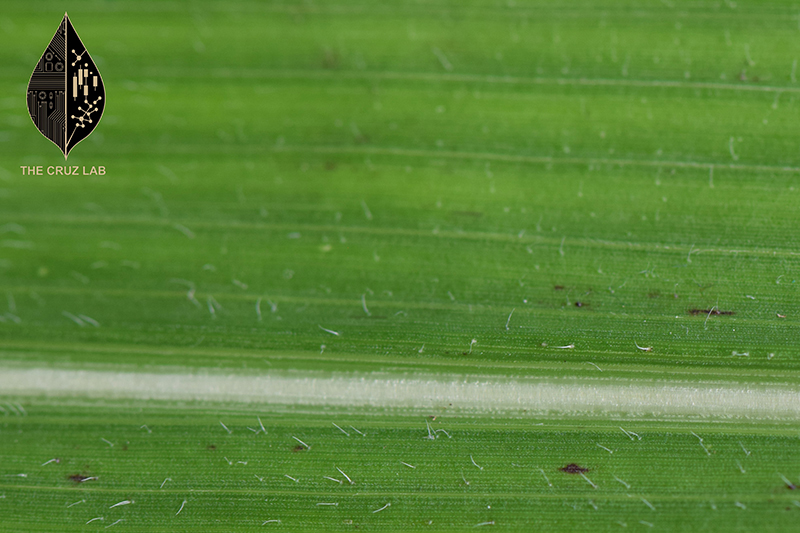Purdue researchers build transparent conductors without expensive rare-earth indium
Purdue University patent-pending polymer technology achieves the same results as indium-based conductors at a lower cost

Postdoctoral researcher Jinhyo Hwang (left) and graduate student Zhifan Ke are members of Purdue University professor Jianguo Mei’s research team that has used patent-pending polymers to create transparent conductors, which are crucial in optoelectronic devices like light-emitting diodes, touch screens and solar cells. The polymers are created from carbon-based materials, which are suitable for roll-to-roll manufacturing in a low-cost and scalable manner. (Purdue University photo/Jianguo Mei)
WEST LAFAYETTE, Ind. —
Purdue University researchers have created transparent organic conductors from patent-pending polymers that achieve the same results and properties as traditional conductors made from rare-earth minerals but are less expensive and can be created from more plentiful reserves.
Transparent conductors are critical components in light-emitting diodes, touch screens, solar cells and other optoelectronic devices. Indium tin oxide (ITO) is used in more than 95% of global transparent conductors. It conducts electric current through a device, which is disrupted when a person swipes or taps a touch screen.
Jianguo Mei, the Richard and Judith Wien Associate Professor of Chemistry in the Department of Chemistry, said touch screens are made of several layers, including a top layer of glass or plastic, a conductive layer beneath it, and a circuit board that reads the signals sent by the conductive layer.
“When a user touches the screen, their finger creates a disruption in the electrical field generated by the conductive layer,” Mei said. “This disruption is detected by the circuit board, which can then determine the location of the touch and interpret it as a command, such as opening an app or typing a message.”
Because ITO is transparent as a thin film, users can view images, text and video through it.
Mei said traditional transparent conductors have drawbacks.
“Indium tin oxide films are mechanically fragile, which makes them undesirable in roll-to-roll manufacturing,” Mei said. “Also, indium is a rare-earth mineral with scarce reserves; the U.S. Geological Survey said the U.S. was 100% reliant on indium imports in 2021. Because demand for ITO films is increasing, the price of indium has soared. This has led to the search for alternatives, including metal mesh, graphene and earth-abundant metal oxides and organic conductors.”
Mei and his research team have created a patent-pending polymer from carbon-based materials that have a lower manufacturing cost and are easier to manufacture into thin films than indium through solution-coating processing. He said performance of the new thin-film transparent conductors also rivals that of conductors made with indium tin oxide.
“The polymer ink is shelf-stable for months under ambient conditions, compared to commercially available PEDOT:PSS,” Mei said. “Our new transparent organic conductors exhibit low sheet resistance and high transmittance compared to any other solution processable transparent conductors. Also, it exhibits excellent durability under accelerated weathering tests.”
Mei and his team’s research was published in the February 2023 issue of the peer-reviewed Journal of the American Chemical Society. He said the next steps to advance the innovation are to continually improve the figure of merit of their organic conductor and develop ink formation for large-scale processing.
Mei disclosed the polymer innovation to the Purdue Research Foundation Office of Technology Commercialization, which has filed for a patent application from the U.S. Patent and Trademark Office to protect the intellectual property. Industry partners interested in further developing the technology for the marketplace should contact Will Buchanan, assistant director of business development – physical sciences, wdbuchanan@prf.org, about 2023-MEI-69956.
Mei received support for the research from the Office of Naval Research
About Purdue University
Purdue University is a top public research institution developing practical solutions to today’s toughest challenges. Ranked in each of the last five years as one of the 10 Most Innovative universities in the United States by U.S. News & World Report, Purdue delivers world-changing research and out-of-this-world discovery. Committed to hands-on and online, real-world learning, Purdue offers a transformative education to all. Committed to affordability and accessibility, Purdue has frozen tuition and most fees at 2012-13 levels, enabling more students than ever to graduate debt-free. See how Purdue never stops in the persistent pursuit of the next giant leap at https://stories.purdue.edu.
About the Purdue Research Foundation Office of Technology Commercialization
The Purdue Research Foundation Office of Technology Commercialization operates one of the most comprehensive technology transfer programs among leading research universities in the U.S. Services provided by this office support the economic development initiatives of Purdue University and benefit the university’s academic activities through commercializing, licensing and protecting Purdue intellectual property.
In fiscal year 2022, the office reported 157 deals finalized with 237 technologies signed, 379 disclosures received and 169 issued U.S. patents. The office is managed by the Purdue Research Foundation, which received the 2019 Innovation and Economic Prosperity Universities Award for Place from the Association of Public and Land-grant Universities. In 2020, IPWatchdog Institute ranked Purdue third nationally in startup creation and in the top 20 for patents. The Purdue Research Foundation is a private, nonprofit foundation created to advance the mission of Purdue University. Contact otcip@prf.org for more information.
Writer/Media contact: Steve Martin, sgmartin@prf.org
Source: Jianguo Mei, jgmei@purdue.edu



